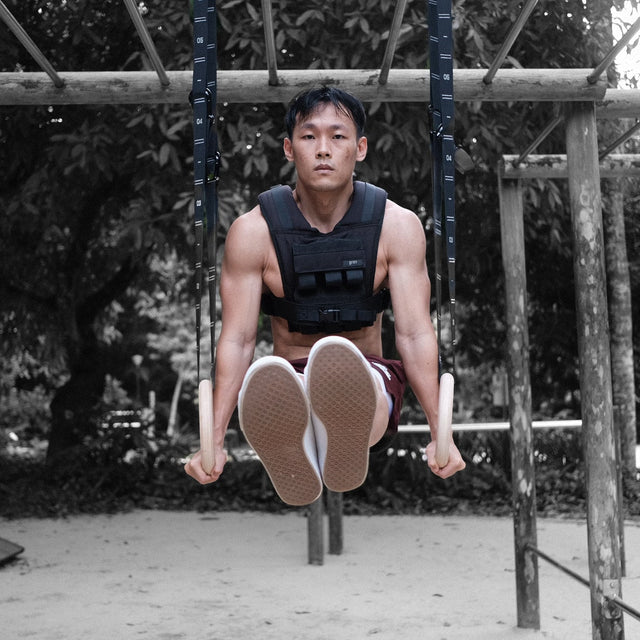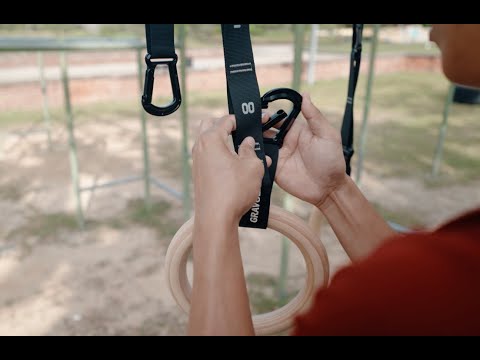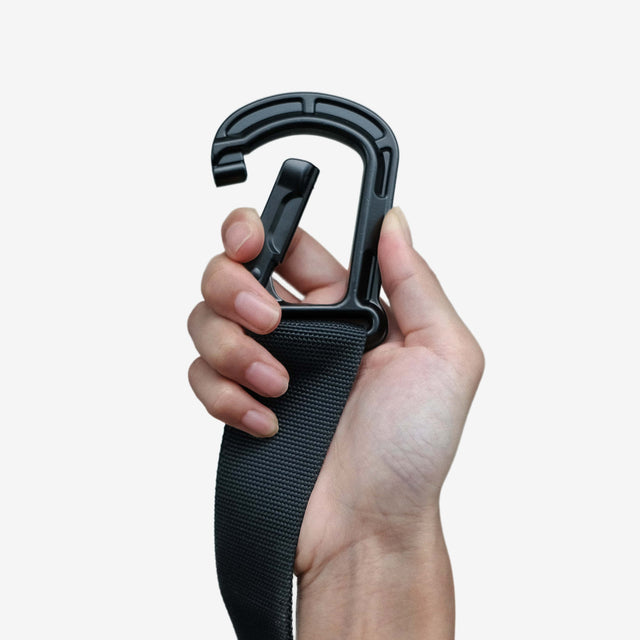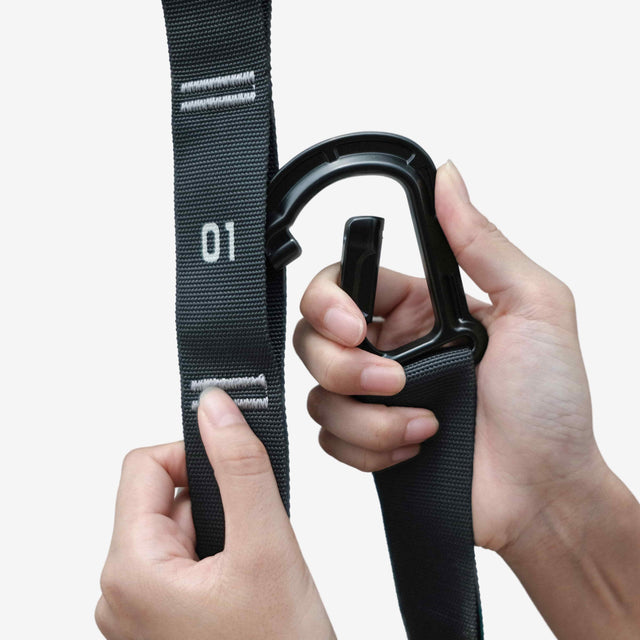12 Mins of Brutally Honest Gymnastic Ring Pull Ups Advice
If you're serious about building strength that lasts, gymnastic ring pull ups are where it’s at. Unlike bar pull ups, rings let you move naturally, keeping your joints in line and cutting down on the wear and tear that comes from a rigid grip. Ring pull ups are pure, functional strength—training that’s as practical as it gets, whether you’re building stability for heavy lifting, training for flexibility, or just looking to be rock-solid in daily life.
We’ll look into these core aspects of gymnastic ring pull ups:
- Why gymnastic ring pull ups?
- Mastering form & technique for gymnastic ring pull ups
- Building strength for ring pull ups
- Joint safety & injury prevention tips
- Progressing from basic to advanced ring pull ups
- Ring pull ups vs. bar pull ups
- Sample weekly workout routine for ring pull ups
- Choosing the right rings & setup
- 3 Common mistakes to avoid
- Embrace the ring pull up challenge
Why gymnastic ring pull ups?
First off, rings are all about control. They challenge those deep stabilizer muscles that don’t get much action on a fixed bar, giving you the grip strength, balance, and body control you need to be strong, not just look at it.
And they’re dead easy to set up anywhere—the park, backyard, or even the bush. With the right rings, you’ve got the freedom to train on your own terms.
This guide lays it all out, with tips to get your form right, build up strength safely, and progress at your own pace.
These are the fundamentals to make gymnastic ring pull ups part of a solid, joint-friendly workout. Whether you’re just getting started or upping your game.
Mastering form & technique for gymnastic ring pull ups
When it comes to gymnastic ring pull ups, proper form is everything. Unlike traditional bar pull ups, rings offer a flexible range of motion that benefits both joint health and muscle engagement—but only if your technique is dialed in. Here’s how to make each rep count.
Natural wrist rotation 👐
One big advantage of ring pull ups is their natural wrist rotation. As you pull up, your wrists can rotate from pronated (palms facing forward) to supinated (palms facing you). This rotation not only makes the movement feel more natural but also takes pressure off the shoulders and elbows—something a fixed bar simply can’t offer.
For anyone with sensitive joints or recovering from strain, this feature can make a massive difference in comfort and long-term durability.
Essential technical tips 💪
To get the most out of every rep, here’s how to manage the mechanics for maximum muscle activation and control:
- Grip options: Start with a neutral grip—palms facing each other—which is generally the most stable and comfortable for beginners. As you gain strength and stability, feel free to experiment with different grips to find what best suits your pull up style.
- Note: When it comes to ring pull ups, there’s no “one-size-fits-all” grip. Instead, experiment with minor adjustments until you find the hand position that feels strongest and most stable for your body. This individualized grip approach helps you work with your natural alignment, which is far more effective (and safer) than trying to copy someone else’s exact form. And leads to greater muscle and strength gains.
- Core stability: Rings tend to swing, so keeping a strong, engaged core is essential. Engage your abs, glutes, and lower back muscles throughout the movement to prevent unnecessary swinging and keep your body steady. With better core stability, you’ll get more out of each rep without losing control or range.
- Controlled descent: Lowering yourself with control is key for muscle engagement. The eccentric phase (lowering) of the pull up is where you build the most strength and stability. Try slowing down your descent to challenge your muscles and improve overall control.
For those needing a visual on how to execute each phase, here’s a useful video breakdown on proper ring pull up form:
Ring pull ups vs. Bar pull ups 🤔
One of the standout benefits of ring pull ups over bar pull ups is their self-regulating movement path. With rings, your body is free to find a natural pulling motion that matches your structure, reducing the risk of overuse injuries. This freedom lets your body adjust throughout the movement, following the optimal angle for each joint’s natural comfort and stability.
Building strength for ring pull ups
Building strength for gymnastic ring pull ups isn’t just about pulling harder—it’s about activating the right muscles, improving grip stability, and using supporting exercises that build a balanced, functional back.
Scapular engagement for balanced back activation 🦴
One of the biggest pitfalls in ring pull ups is letting the biceps do most of the work. Not only does this limit your gains, but it also throws off your form. Focusing on scapular engagement will help you avoid bicep dominance, distributing the effort to your entire back.
Start each pull up by pulling your shoulder blades down and back (also called “packing” the scapula). This initial movement ensures that your back muscles—especially the lats—are driving the pull, not just the arms. It’s the key to balanced activation that builds real strength and control.
Wrist & grip strength tips ✊
Strong, stable wrists and a solid grip are essential for maximizing strength on the rings. Here’s how to get there:
- Grip stability: Rings are designed to challenge your forearms and grip muscles, making each pull up a functional grip workout in itself. This instability trains the forearms, wrists, and deep stabilizers in ways a bar simply can’t.
- Supporting movements: If you’re serious about building grip strength, add a few targeted movements to your routine:
- Dead hangs: Hang from the rings with arms fully extended. This simple hold builds wrist endurance and grip strength over time.
- Grip holds: Set the rings at a low height and practice gripping and holding, or even doing rows, with minimal swing. This exercise helps build the stability needed for full ring pull ups.
Adding these movements to your routine will give you a stronger foundation for ring pull ups, improving not just your grip but your overall control throughout each rep. 💥
Joint safety & injury prevention tips
One of the biggest advantages of gymnastic ring pull ups is the ability to protect your joints while still gaining serious strength. Rings allow your body to move naturally, which can make a huge difference in shoulder and elbow health. Here’s how to stay injury-free while getting stronger.
Reduce joint strain with natural range of motion 😇
Rings are ideal for joint health because they give your body the freedom to adjust to its natural movement patterns. As you pull up, your wrists, elbows, and shoulders can all move fluidly, reducing the strain and fixed angles that bars impose. This freedom helps avoid the rigid stresses that often lead to overuse injuries in traditional pull ups. For those training with longevity in mind, rings offer a significant advantage.
Safety tips for a solid start
To keep your joints safe and get the most out of each rep, follow these key safety tips:
- Neutral grip for beginners: For those just getting into ring pull ups, start with a neutral grip (palms facing each other). This is generally the most comfortable position for beginners and can reduce unnecessary strain on the wrists and elbows. As you get more comfortable, feel free to adjust your grip to match your preferred pulling style.
- Avoiding common mistakes: Watch out for over-flaring elbows and poor scapula engagement—two common pitfalls that can put you at risk for shoulder or elbow pain. Keep your elbows close to your body, and remember to engage your shoulder blades at the start of each pull to distribute the load effectively.
Form check for alignment & stability 🔍
Proper form isn’t a one-time check; it’s something to reassess periodically. Take a moment during each set to check your alignment and make sure you’re pulling with control.
Are your shoulder blades engaged? Are your elbows staying close? This quick form check can help you correct any misalignments and ensure you’re training safely and effectively every time you hit the rings.
Staying mindful of your form, grip, and alignment will go a long way in making ring pull ups a joint-friendly and powerful exercise.
Progressing from basic to advanced ring pull ups
One of the best things about gymnastic ring pull ups is how adaptable they are—there’s always room to level up. Here’s a progression path from basic to advanced, so you can build rock-solid strength with every stage.
| Level | Progression | Details |
| Beginner | Assisted pull ups | Use a box or resistance band to lighten the load. This builds strength without overloading. |
| Ring rows | Set rings low and row with feet on the ground. Great for training back, biceps, & grip. | |
| Intermediate | Full ring pull ups | Focus on steady, controlled reps, with a strong pull and slow descent. |
| Controlled movement | Keep core and scapula engaged to prevent swinging and keep the pull powered by your back. | |
| Advanced | L-sits | Pull up while holding an L-sit, with legs extended to build serious core stability and control. |
| Weighted pull ups | Add weight gradually with a vest or light plates to increase resistance and muscle gains. | |
| Muscle-ups | Pull with explosive force to transition above the rings—a powerhouse move for total strength. |
Mastering each progression
Starting with assisted pull ups and ring rows builds up that solid foundation you need for safe progress. Mastering these beginner moves is crucial for anyone looking to build lasting strength and control from day one.
When you’re ready for the next level, focus on controlled movement.
Full ring pull ups are all about smooth, powerful reps with minimal swinging. This is where you refine form and build muscle activation.
For advanced ring pull ups, each variation targets different muscles to boost total strength and stability. Whether you’re holding an L-sit, adding weight, or tackling muscle-ups, advanced moves challenge you on all fronts, pushing strength and coordination to new heights.
Experiment with grips & pauses
One of the biggest benefits of rings is freedom in movement. As you advance, try experimenting with grip twists (rotating slightly to match your natural motion) or pauses at the top (holding for a few seconds). Both tweaks increase time under tension and challenge your stabilizer muscles, helping you break through plateaus and strengthen from every angle.
Ring pull ups vs. bar pull ups
Rings and bars may look similar, but they offer totally different benefits when it comes to building upper body strength. Each has a unique advantage, and if you’re serious about functional strength and joint health, understanding their differences can make all the difference.
Self-regulating movement
One major advantage of ring pull ups is their natural, self-regulating path.
With a fixed bar, your grip and elbow position are locked in, which can lead to shoulder and elbow discomfort over time. Rings, on the other hand, allow your body to find its natural pulling path—wrist rotation, shoulder alignment, and elbow angle all adjust to what feels right for your structure.
This freedom can help prevent the repetitive stress injuries often associated with bar pull ups.
For a clear visual of the benefits, you can see the difference in movement paths between rings and bars:
Benefits comparison
| Type | Strengths |
| Bar pull ups | Excellent for stability, allowing you to pull more weight, which makes them ideal for max load training. |
| Ring pull ups | Great for joint protection, core engagement, and total-body activation, giving you a dynamic, functional strength workout. |
Bar pull ups are unbeatable when it comes to stability. They allow you to lock in, focus on raw pulling power, and move more weight.
If max load is your main goal, bars are where it’s at.
Ring pull ups, however, work every stabilizer muscle and demand far more from your core. Because rings move freely, they engage your entire upper body in a balanced, functional way.
This makes them the better choice for joint safety and building all-around strength.
Use both for balanced strength
Both types have their place in a well-rounded training routine. Start with bar pull ups to maximize pulling strength, then switch to rings for core engagement and joint-friendly movement. Alternating between the two gives you the best of both worlds—strength and stability from bar work, plus control and injury prevention from rings.
Sample weekly workout routine for ring pull ups
Integrating gymnastic ring pull ups into your weekly routine doesn’t need to be complicated. This simple, adaptable plan provides structure whether you’re just starting out or looking to step up to more advanced variations.
| Experience Level | Frequency | Routine |
| Beginner | 2x/week | Focus on assisted pull ups (using a box or band) and dead hangs to build basic strength and control. |
| Intermediate to advanced | 3x/week | Alternate between weighted pull ups, high-rep sets for endurance, and skill work like L-sits to build versatility. |
For beginners, this routine focuses on controlled foundational movements. Assisted pull ups allow you to get familiar with the rings while dead hangs build grip and joint strength. Stick to this twice a week, giving your muscles time to adapt.
For intermediate to advanced athletes, adding variety to each session will help maximize gains and prevent plateaus. Weighted pull ups build strength, high-rep sets improve endurance, and skills like L-sits enhance core control and full-body stability.
Frequency & volume tips
Start small and build gradually. If you’re new, stick to 2x/week, and keep the sets and reps manageable. For more experienced athletes, gradually increase the number of sets or add a third day to intensify your training. Remember, quality reps are more important than pushing volume, so prioritize control and technique over simply adding reps.
A slow, steady increase in volume will keep your progress consistent and sustainable.
Choosing the right rings & setup
For optimal versatility and comfort, here are the essentials for selecting your gymnastic rings:
Strap length?
Go for 15'-20' straps. This length offers flexibility for setting up rings at different heights, whether in the gym, park, or garage.
Grip size?
1.2’ rings are ideal for general use, providing a secure grip. If you’re focusing on advanced grip strength, 1” rings offer an extra challenge.
Material?
Wooden rings are highly recommended—they provide a comfortable, non-slip grip that stands up to intense use.
For a detailed setup and installation guide, check out our in-depth blog on ring setup. This guide covers everything from secure mounting to optimal heights for various exercises.
3 Common mistakes to avoid
Even with gymnastic ring pull ups, there are a few common missteps that can hold back your progress or even risk injury. Here are the top three mistakes to watch out for, along with quick fixes for each.
1️⃣Swinging
Rings are naturally unstable, so if you’re swinging, it’s often a sign of losing control.
Quick fix: Engage your core throughout the movement, and focus on a slow, controlled descent.
2️⃣Narrow elbows
Pulling with elbows tucked too close can strain the shoulders and reduce back engagement.
Quick fix: Keep your shoulders stable, with elbows aligned to allow for a natural, powerful pull.
3️⃣Incomplete range
Shortening your range limits muscle activation.
Quick fix: Start each rep from a full dead hang to activate your muscles fully and build balanced strength.
Prioritize form over reps
With ring pull ups, quality always beats quantity. Focus on clean, controlled reps rather than rushing to hit high numbers. This approach will give you long-term gains that actually last.
Embrace the ring pull up challenge
By allowing natural movement, rings protect your joints while demanding control and engagement from your entire body.
Ring pull ups are a powerful addition to any strength routine, whether you’re working on basic stability or tackling advanced variations.
So, give ring pull ups a try, and experience firsthand how they transform your strength and stability.
Have any questions or progress to share? Drop a comment, join the Gravgear telegram group, link this blog to your training comrades, and let’s push each other to reach new levels 💪😠










0 Comments
There are no comments for this article. Be the first one to leave a message!